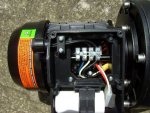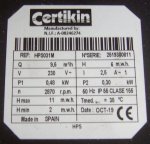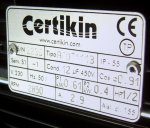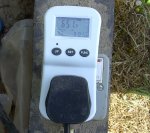I have upgraded my pump, filter and pipework to a design that requires a low flow rate (don't ask, I will explain but that's not the question). I need 5 cu mtrs (1,315 US gall an hour, 22 USG a min) across the filter. I have installed a Certikin HPS031M 1/3 HP pump which gives 6.3 cu mtrs/hr at 8 mtrs head. The head on my system is probably below 8 mtrs. However I have questions about the pump, specifically its motor (I'm UK but the basics are the same)
The pump has two labels on it, a sticky with 1/3 HP, P1 480 watts, P2 300 watts, as expected. It also had a riveted label saying 1/2 HP, P1 610 watts, P2 400 watts, not as expected. Certikin say that they may be labelling 1/2 HP pumps as 1/3 HP, as sales are minimal. But that wouldn't explain the differing P1 and P2 figures.
The pump connections had two very thin wires connected to them on the input side, terminated (just cut off) at the cable in gland. I discarded these. What could they have been used, or intended, for?
The pump is running, and a meter shows 650 watts being used. This, to me, is a 1/2 HP motor running at its max limit. The motor is very hot, too hot to keep a finger on. The pressure on the filter is 7.5 psi, which is nothing. The pipework is short and simple and the flow back to the pool feels strong. I believe that this wattage is excessive, and will be expensive and will eventually damage the motor. My not very deep understanding of electrics is that a motor under a low load will use less power, and power equals watts.
I am perplexed by this. Is this normal? Why is the motor running flat out? What were the thin wires used for? Any help would be appreciated. The pic shows the two wires from the power in terminals to the cable gland, where they are cut.
The pump has two labels on it, a sticky with 1/3 HP, P1 480 watts, P2 300 watts, as expected. It also had a riveted label saying 1/2 HP, P1 610 watts, P2 400 watts, not as expected. Certikin say that they may be labelling 1/2 HP pumps as 1/3 HP, as sales are minimal. But that wouldn't explain the differing P1 and P2 figures.
The pump connections had two very thin wires connected to them on the input side, terminated (just cut off) at the cable in gland. I discarded these. What could they have been used, or intended, for?
The pump is running, and a meter shows 650 watts being used. This, to me, is a 1/2 HP motor running at its max limit. The motor is very hot, too hot to keep a finger on. The pressure on the filter is 7.5 psi, which is nothing. The pipework is short and simple and the flow back to the pool feels strong. I believe that this wattage is excessive, and will be expensive and will eventually damage the motor. My not very deep understanding of electrics is that a motor under a low load will use less power, and power equals watts.
I am perplexed by this. Is this normal? Why is the motor running flat out? What were the thin wires used for? Any help would be appreciated. The pic shows the two wires from the power in terminals to the cable gland, where they are cut.





